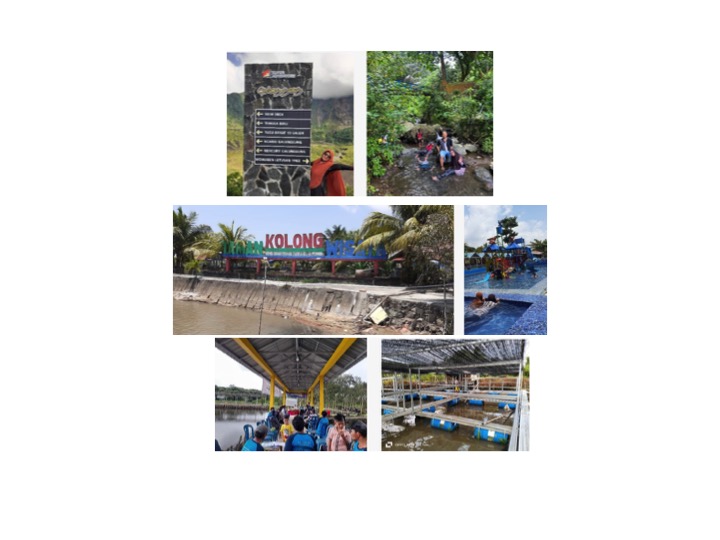Coastal Tourism Potential by Increasing Tourism Attractions based on Sustainable Aquatic Resources
DOI:
https://doi.org/10.46252/jsai-fpik-unipa.2023.Vol.7.No.4.383Keywords:
Aquatic resources, attraction, destination, environmen, tiurismAbstract
Developing tourist attractions can encourage increased community participation in managing tourist destinations, especially those based on water resource potential. Local or domestic tourists are the backbone of most tourism destinations. Therefore, challenges, opportunities, and innovation in optimizing the potential of aquatic resources require sharing information based on experience in several regions. The research aims to assess the potential for sustainable water resource-based tourist attractions. This research was conducted from March 2022 to August 2023 in 9 districts/cities with tourist destinations. The method uses qualitative methods through field observations and literature studies. The results show that coastal tourism management must consider tourist attractions, carrying capacity, infrastructure, facilities, and services. Tourist attractions can motivate tourists to visit. Tourists find out about tourist destinations usually based on information from the internet, from friends/relatives, and social media. Clean water facilities at tourist locations are essential, especially during peak season. The sources of income for tourism managers comes from entrance tickets to tourist locations, sponsorships, and rides. The mode of transportation for domestic tourists is dominated by cars and motorbikes. Some examples of tourist attractions visited include tourism educational activities such as salt making, mangrove crab rearing of apartment system, fishing, culinary, sponsorship, lodging, swimming pools, fish therapy, photo boats, viewing panoramic views of beaches, mangroves, swimming, snorkeling and diving on coral reefs. Tourist destinations provide economic benefits and sources of income. Sustainable tourism promotes economic growth, social inclusion, environmental protection, and tourism governance.Downloads
References
Adibrata, S., Sari, F. I. P., Andriyadi, A., & Harto, B. (2021). Potensi kualitatif produksi garam dari perairan Pantai Lubuk dan Pantai Takari, Bangka Belitung. Buletin Oseanografi Marina, 10(1), 13-22.
Akay, B. (2022). The relationship between tourism development, satisfaction, support to tourism and tourism entrepreneurship in emerging tourism destination: Residents’ perspective. Journal of Tourism Management Research, 9(1), 64-81.
Anggraeni, P. W. P., Antara, M., & Ratna Sari, N. P. (2022). Pengaruh Daya Tarik Wisata dan Citra Destinasi Terhadap Niat Berkunjung Kembali yang Dimediasi oleh Memorable Tourism Experience. Jurnal Master Pariwisata (JUMPA), 9(1), 179-197.
Anggriana, S., Piartrini, P. S., & Sukaatmadja, I. P. G. (2022). Intensitas berkunjung wisatawan domestic ke Pantai Kuta Mandalika, Lombok. Jurnal Master Pariwisata (JUMPA), 9(1): 198-221.
Aquino, R. S. (2022). Community change through tourism social entrepreneurship. Annals of Tourism Research, 95, 103442.
Chandra, T. (2022). Studi identifikasi potensi pariwisata & kuliner Kabupaten Indramayu, Provinsi Jawa Barat. Jurnal Master Pariwisata (JUMPA), 9(1), 382-422.
Fitroh, S. K. A., Hamid, D., & Hakim, L. (2017). Pengaruh Atraksi Wisata dan Motivasi Wisatawan Terhadap Keputusan Berkunjung (Survei pada Pengunjung Wisata Alam Kawah Ijen). Jurnal Administrasi Bisnis (JAB), 42(2).
Gossling, S., Hall, C. M., & Scott, D. (2015). Tourism and water. Channel View Publications. UK – USA – Canada.
Jamal, T. B., & Getz, D. (1995). Collaboration theory and community tourism planning. Annals of Tourism Research, 22(1), 186-204.
Kimbu, A. N., Booyens, I., & Winchenbach, A. (2022). Livelihood diversification through tourism: identity, well-being, and potential in rural coastal communities. Tourism review international, 26(1), 25-40.
Mauludin, R. (2017). Pengaruh Atraksi Wisata Terhadap Minat Berkunjung Wisatawan Ke Daya Tarik Wisata Waduk Darma Kabupaten Kuningan. Jurnal Manajemen Resort Dan Leisure, 14(2), 57-68.
Muharromah, G. L., & Anwar, M. K. (2020). Pengaruh Atraksi Wisata, Amenitas dan Aksesibilitas Terhadap Keputusan Berkunjung Pada Objek Wisata Religi Makam Kh. Abdurrahman Wahid. Jurnal Ekonomika dan Bisnis Islam, 3(2), 152-164.
Prayitno, A. A., Winarno, G. D., Rusita, R. R., & Harianto, S. P. (2021). Persepsi wisatawan terhadap objek daya tarik wisata di Pantai Ketapang, Kabupaten Pesawaran, Provinsi Lampung. Journal of Tropical Marine Science, 4(2), 65-72.
Putra, A., Dewata, I., Hermon, D., Barlian, E., & Umar, G. (2023). Sustainable Development-Based Coastal Management Policy Development: A Literature Review. Journal of Sustainability Science and Management, 18(1), 238-246.
Putra, M. S. P., Yustiani, D., & Astawa, I. N. D. (2021). Wisatawan nusantara sebagai pengungkit ekonomi Bali di era pandemi covid-19. Jurnal Ilmiah Hospitality Management, 12(1), 59-73.
Putra, T. R. (2013). Peran Pokdarwis dalam Pengembangan Atraksi Wisata di Desa Wisata Tembi, Kecamatan Sewon Kabupaten Bantul. Jurnal Pembangunan Wilayah & Kota, 9(3), 225.
Ramadhani, S. A., Setiawan, H., & Rini, R. (2021). Analisis Pengaruh Atraksi Wisata, dan Ancillary Service terhadap Minat Kunjung Ulang pada Objek Wisata Bukit Siguntang. Jurnal Terapan Ilmu Ekonomi, Manajemen dan Bisnis, 1(3), 124-133.
Rasoolimanesh, S. M., Ramakrishna, S., Hall, C. M., Esfandiar, K., & Seyfi, S. (2023). A systematic scoping review of sustainable tourism indicators in relation to the sustainable development goals. Journal of Sustainable Tourism, 31(7), 1497-1517.
Riadi, S., Normelani, E., Bachri, A. A., Hidayah, N., & Sari, Y. P. (2020). Rancangan atraksi wisata edukasi di kampung hijau Kota Banjarmasin. J-PIPS (Jurnal Pendidikan Ilmu Pengetahuan Sosial), 7(1), 37-44.
Stan, M. I. (2022). The Priorities of Romanian Coastal and Maritime Tourism From The Perspective of Land and Sea Interactions. Ovidius University Annals, Economic Sciences Series, 22(2), 170-179.
Utari, D. R. (2017). Pengembangan atraksi wisata berdasarkan penilaian dan preferensi wisatawan di kawasan mangrove Karangsong, Kabupaten Indramayu. Jurnal Manajemen Resort dan Leisure, 14(2), 83-99.
[UU 1 tahun 2014] Undang-undang Nomor 1 tahun 2014. (2014). Perubahan atas UU No. 27 tahun 2007 tentang pengelolaan wilayah pesisir dan pulau-pulau kecil. Jakarta.
[UU 10 tahun 2009] Undang-undang Nomor 10 tahun 2009. (2009). Kepariwisataan. Jakarta.
[UU 27 tahun 2007] UU No. 27 tahun 2007. Pengelolaan wilayah pesisir dan pulau-pulau kecil. Jakarta.
Weis, K., Chambers, C., & Holladay, P.J. (2021) Social-ecological resilience and community-based tourism in the commonwealth of Dominica, Tourism Geographies. https://doi.org/10.1080/14616688.2021.1878267
Widodo, E. (2017). Pengembangan atraksi wisata Pantai Tanjung Karang sebagai kawasan wisata bahari di Kabupaten Donggala. Katalogis, 5(4).
Yuniati, N. (2018). Profil dan karakteristik wisatawan nusantara (studi kasus di Yogyakarta). Jurnal Pariwisata Pesona, 3(2), 175-190.

Downloads
Published
How to Cite
Issue
Section
License
Copyright (c) 2023 Sudirman Adibrata, Umroh Umroh, Franto Franto, Siti Fatimah

This work is licensed under a Creative Commons Attribution-ShareAlike 4.0 International License.


















